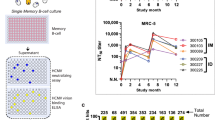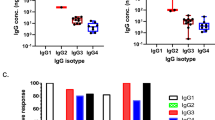Abstract
Antibodies to conserved epitopes on the human immunodeficiency virus (HIV) surface protein gp140 can protect against infection in non-human primates, and some infected individuals show high titres of broadly neutralizing immunoglobulin (Ig)G antibodies in their serum. However, little is known about the specificity and activity of these antibodies1,2,3. To characterize the memory antibody responses to HIV, we cloned 502 antibodies from HIV envelope-binding memory B cells from six HIV-infected patients with broadly neutralizing antibodies and low to intermediate viral loads. We show that in these patients, the B-cell memory response to gp140 is composed of up to 50 independent clones expressing high affinity neutralizing antibodies to the gp120 variable loops, the CD4-binding site, the co-receptor-binding site, and to a new neutralizing epitope that is in the same region of gp120 as the CD4-binding site. Thus, the IgG memory B-cell compartment in the selected group of patients with broad serum neutralizing activity to HIV is comprised of multiple clonal responses with neutralizing activity directed against several epitopes on gp120.
This is a preview of subscription content, access via your institution
Access options
Subscribe to this journal
Receive 51 print issues and online access
$199.00 per year
only $3.90 per issue
Buy this article
- Purchase on Springer Link
- Instant access to full article PDF
Prices may be subject to local taxes which are calculated during checkout




Similar content being viewed by others
References
Mascola, J. R. HIV/AIDS: allied responses. Nature 449, 29–30 (2007)
Karlsson Hedestam, G. B. et al. The challenges of eliciting neutralizing antibodies to HIV-1 and to influenza virus. Nature Rev. Microbiol. 6, 143–155 (2008)
Zolla-Pazner, S. Identifying epitopes of HIV-1 that induce protective antibodies. Nature Rev. Immunol. 4, 199–210 (2004)
Shibata, R. et al. Neutralizing antibody directed against the HIV-1 envelope glycoprotein can completely block HIV-1/SIV chimeric virus infections of macaque monkeys. Nature Med. 5, 204–210 (1999)
Mascola, J. R. et al. Protection of Macaques against pathogenic simian/human immunodeficiency virus 89.6PD by passive transfer of neutralizing antibodies. J. Virol. 73, 4009–4018 (1999)
Trkola, A. et al. Delay of HIV-1 rebound after cessation of antiretroviral therapy through passive transfer of human neutralizing antibodies. Nature Med. 11, 615–622 (2005)
Wei, X. et al. Antibody neutralization and escape by HIV-1. Nature 422, 307–312 (2003)
Tiller, T. et al. Efficient generation of monoclonal antibodies from single human B cells by single cell RT-PCR and expression vector cloning. J. Immunol. Methods 329, 112–124 (2008)
Scheid, J. F. et al. A method for identification of HIV gp140 binding memory B cells in human blood. J. Immunol. Methods 10.1016/j.jim.2008.11.012 (in the press)
Mietzner, B. et al. Autoreactive IgG memory antibodies in patients with systemic lupus erythematosus arise from nonreactive and polyreactive precursors. Proc. Natl Acad. Sci. USA 105, 9727–9732 (2008)
Tiller, T. et al. Autoreactivity in human IgG+ memory B cells. Immunity 26, 205–213 (2007)
Huang, C. C. et al. Structural basis of tyrosine sulfation and VH-gene usage in antibodies that recognize the HIV type 1 coreceptor-binding site on gp120. Proc. Natl Acad. Sci. USA 101, 2706–2711 (2004)
Muster, T. et al. A conserved neutralizing epitope on gp41 of human immunodeficiency virus type 1. J. Virol. 67, 6642–6647 (1993)
Zwick, M. B. et al. Broadly neutralizing antibodies targeted to the membrane-proximal external region of human immunodeficiency virus type 1 glycoprotein gp41. J. Virol. 75, 10892–10905 (2001)
Xu, J. Y., Gorny, M. K., Palker, T., Karwowska, S. & Zolla-Pazner, S. Epitope mapping of two immunodominant domains of gp41, the transmembrane protein of human immunodeficiency virus type 1, using ten human monoclonal antibodies. J. Virol. 65, 4832–4838 (1991)
Pantophlet, R. et al. Fine mapping of the interaction of neutralizing and nonneutralizing monoclonal antibodies with the CD4 binding site of human immunodeficiency virus type 1 gp120. J. Virol. 77, 642–658 (2003)
Olshevsky, U. et al. Identification of individual human immunodeficiency virus type 1 gp120 amino acids important for CD4 receptor binding. J. Virol. 64, 5701–5707 (1990)
Thali, M. et al. Characterization of a discontinuous human immunodeficiency virus type 1 gp120 epitope recognized by a broadly reactive neutralizing human monoclonal antibody. J. Virol. 65, 6188–6193 (1991)
Thali, M. et al. Characterization of conserved human immunodeficiency virus type 1 gp120 neutralization epitopes exposed upon gp120–CD4 binding. J. Virol. 67, 3978–3988 (1993)
Kwong, P. D. et al. Structure of an HIV gp120 envelope glycoprotein in complex with the CD4 receptor and a neutralizing human antibody. Nature 393, 648–659 (1998)
Gorny, M. K. et al. Neutralization of diverse human immunodeficiency virus type 1 variants by an anti-V3 human monoclonal antibody. J. Virol. 66, 7538–7542 (1992)
Li, Y. et al. Broad HIV-1 neutralization mediated by CD4-binding site antibodies. Nature Med. 13, 1032–1034 (2007)
Zhou, T. et al. Structural definition of a conserved neutralization epitope on HIV-1 gp120. Nature 445, 732–737 (2007)
Li, M. et al. Human immunodeficiency virus type 1 env clones from acute and early subtype B infections for standardized assessments of vaccine-elicited neutralizing antibodies. J. Virol. 79, 10108–10125 (2005)
Burton, D. R. et al. A large array of human monoclonal antibodies to type 1 human immunodeficiency virus from combinatorial libraries of asymptomatic seropositive individuals. Proc. Natl Acad. Sci. USA 88, 10134–10137 (1991)
Buchacher, A. et al. Generation of human monoclonal antibodies against HIV-1 proteins; electrofusion and Epstein-Barr virus transformation for peripheral blood lymphocyte immortalization. AIDS Res. Hum. Retroviruses 10, 359–369 (1994)
Trkola, A. et al. Human monoclonal antibody 2G12 defines a distinctive neutralization epitope on the gp120 glycoprotein of human immunodeficiency virus type 1. J. Virol. 70, 1100–1108 (1996)
Yang, X., Farzan, M., Wyatt, R. & Sodroski, J. Characterization of stable, soluble trimers containing complete ectodomains of human immunodeficiency virus type 1 envelope glycoproteins. J. Virol. 74, 5716–5725 (2000)
Wardemann, H. et al. Predominant autoantibody production by early human B cell precursors. Science 301, 1374–1377 (2003)
Acknowledgements
We thank D. Wycuff, E. Lybarger and B. Dey for supplying gp120 proteins for mapping studies, K. McKee for serum adsorption studies and N. Doria-Rose for her work with patient material from patients 4 and 6. This research was supported by the Rockefeller University, the International Aids Vaccine Initiative, the Bill and Melinda Gates Foundation, the Intramural Research Program of the Vaccine Research Center (R.T.W., J.R.M.), and the Division of Intramural Research (M.C.), National Institute of Allergy and Infectious Diseases, National Institutes of Health. J.F.S. was supported by the Deutscher Akademischer Austauschdienst, H.M. was supported by the Fondation Recherche Médicale. M.C.N. is a Howard Hughes Medical Institute investigator.
Author information
Authors and Affiliations
Corresponding author
Supplementary information
Supplementary Information
This file contains Supplementary Methods, a Supplementary Reference, Supplementary Figures 1-10 with Legends and Supplementary Tables 1-6. (PDF 1254 kb)
Rights and permissions
About this article
Cite this article
Scheid, J., Mouquet, H., Feldhahn, N. et al. Broad diversity of neutralizing antibodies isolated from memory B cells in HIV-infected individuals. Nature 458, 636–640 (2009). https://doi.org/10.1038/nature07930
Received:
Accepted:
Published:
Issue Date:
DOI: https://doi.org/10.1038/nature07930
This article is cited by
-
Assessing immunogenicity barriers of the HIV-1 envelope trimer
npj Vaccines (2023)
-
The rapid and highly parallel identification of antibodies with defined biological activities by SLISY
Nature Communications (2023)
-
HIV-1 treatment timing shapes the human intestinal memory B-cell repertoire to commensal bacteria
Nature Communications (2023)
-
Honing-in antigen-specific cells during antibody discovery: a user-friendly process to mine a deeper repertoire
Communications Biology (2022)
-
Broadly neutralizing anti-HIV-1 antibodies tether viral particles at the surface of infected cells
Nature Communications (2022)
Comments
By submitting a comment you agree to abide by our Terms and Community Guidelines. If you find something abusive or that does not comply with our terms or guidelines please flag it as inappropriate.



